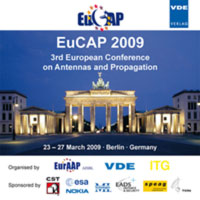On the Capacity Evaluation of a Land Mobile Satellite System Using Multiple Element Antennas at the Receiver
Konferenz: EuCAP 2009 - 3rd European Conference on Antennas and Propagation
23.03.2009 - 27.03.2009 in Berlin, Germany
Tagungsband: EuCAP 2009
Seiten: 5Sprache: EnglischTyp: PDF
Persönliche VDE-Mitglieder erhalten auf diesen Artikel 10% Rabatt
Autoren:
Moraitis, Nektarios; Constantinou, Philip (Institute of Communications and Computer Systems, National Technical University of Athens, 9 Heroon Polytechniou str. 15773, Zografou, Athens, Greece)
Horváth, Péter; Frigyes, István (Budapest University of Technology and Economics, Goldmann Gyorgy tér 3, 1111, Budapest, Hungary)
Inhalt:
Land Mobile Satellite (LMS) can exploit multipleinput- multiple-output (MIMO) techniques in order to achieve high transmission rates. This paper evaluates theoretically the capacity of single-input-multiple-output (SIMO) system utilizing uniform linear arrays at the receiver terminal for satellite applications. Additionally polarization effects are introduced and capacity results taking into account depolarization are presented. The theoretical study is performed at three different frequency bands. Iotan a heavy shadowing scenario the capacity drops significantly comparable with the light shadowing case. It reduces, in average, 1.4-1.7 b/s/Hz. The cost of depolarization in a Rayleigh-fading channel is about 4.2 dB. The average reduction of capacity due to depolarization is approximately 1.2 b/s/Hz. If we have four elements at the receiver and a required capacity of 6 b/s/Hz, in case of depolarization, we have to increase 4 dB the SNR so as to achieve the same capacity with the polarized state.


